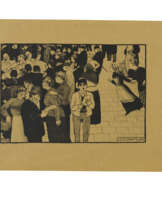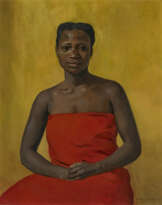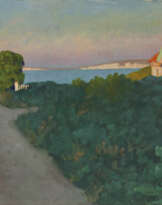ID 1053094
Lot 351 | Félix Vallotton (1865-1925)
Estimate value
€ 300 000 – 500 000
La Porte Dauphine
signé et daté ‘F.. VALLOTTON. 22’ (en bas à droite)
huile sur toile
60.4 x 81.1 cm.
Peint en 1922
signed and dated 'F.. VALLOTTON. 22' (lower right)
oil on canvas
23 ¾ x 31 7⁄8 in.
Painted in 1922
Provenance
Galerie Druet, Paris (acquis auprès de l’artiste en 1922).
Docteur E. Ammann, Winterthour (en 1926 et jusqu'à au moins 1942).
Emmy Scheibli-Ammann, Genève (par descendance).
Maria Pia Scheibli, Genève (par descendance en 1992).
Acquis auprès de celle-ci par la famille du propriétaire actuel en 2001.
Literature
Livre de Raison, no. 1394 (listé ‘LRZ 1394: La Porte dauphine, matin ensoleillé, des autos des promeneurs et des cyclistes (T 25 P)').
H. Hahnloser-Bühler, Félix Vallotton et ses amis, Paris, 1936, p. 26, no. 45 (illustré).
M. Ducrey et K. Poletti, Félix Vallotton, L'œuvre peint, Catalogue raisonné, Seconde partie, 1910-1925, Lausanne, 2005, vol. III, p. 778-779, no. 1468 (illustré en couleurs, p. 779).
Exhibited
Zurich, Kunsthaus, Félix Vallotton, novembre-décembre 1938, p. 28, no. 164.
Bâle, Kunsthalle, Félix Vallotton, février-mars 1942, p. 26, no. 231.
Further details
Conservée dans la même collection depuis plus de vingt ans, et non vue par le public depuis les expositions personnelles de Vallotton en 1938 et 1942, respectivement au Kunsthaus de Zurich et à la Kunsthalle de Bâle, La Porte Dauphine de Félix Vallotton est l'une de ses scènes parisiennes tardives, exécutée avec une audace et une modernité saisissantes. Un tableau de Kees Van Dongen représentant La Porte Dauphine et daté d'environ 1923, presque l'année où Vallotton a réalisé sa peinture, sera proposé dans la vente de Chefs-d'œuvre de la collection de Sam Josefowitz, A Lifetime of Discovery and Scholarship qui se tiendra chez Christie's Londres le 13 octobre 2023. La Porte Dauphine de Van Dongen capture le bon ton de la capitale française, montré dans leurs plus belles tenues se promenant le long de l'avenue du Bois de Boulogne, aujourd'hui connue sous le nom d'avenue Foch. Sous un ciel serein, des hommes en costume et des femmes sveltes et élancées marchent tranquillement sur la grande avenue de La Porte Dauphine. Des jardins luxuriants bordent la route et, à l'arrière-plan, se dresse l'Arc de Triomphe. Contrairement à Van Dongen qui a choisi un format vertical et une vue frontale, soulignant la sveltesse de ses personnages et la perspective menant à l'Arc de Triomphe, Vallotton a opté pour un format horizontal et choisi un angle latéral, de sorte que le point de fuite - également l'Arc de Triomphe, mais qui n'est pas visible dans la composition - peut facilement être imaginé à l'extrémité de la diagonale qui dessine l'avenue du Bois de Boulogne (avenue Foch).
De ce point de vue, Vallotton semble beaucoup plus influencé par la photographie et le jeu avec les différents angles. Nombre de ses chefs-d'œuvre témoignent de l'audace de Vallotton pour représenter des scènes banales de rue ou de parc sous un angle totalement nouveau, comme dans Le Ballon (1899 ; Musée d'Orsay, Paris), ou sous un angle latéral comme dans la présente œuvre ou dans Le Pont Neuf à Paris (1901 ; Kunstmuseum, Winterthur). Dans La Porte Dauphine, Vallotton offre un instantané de la vie moderne parisienne, saisissant son effervescence et immortalisant dans son tableau la façon dont les nouvelles inventions du XIXe siècle - la bicyclette et l'automobile - ont désormais conquis la société moderne. Telles des fourmis montant et descendant systématiquement un chemin, les automobilistes et les motards de Vallotton, dispersés dans la diagonale de l'avenue Foch, sont devenus ses outils pour souligner la perspective de la composition en jouant sur les différentes tailles. Vallotton réussit ainsi à traduire le mouvement incessant et le bruit provoqué par le flux ininterrompu de voitures et de vélos circulant sur les grandes avenues de Paris. Les chevaux et les charrettes ont été remplacés par de nouveaux véhicules qui circulent côte à côte avec les piétons, que Vallotton utilise également comme éléments de composition pour aboutir au point de fuite de son tableau.
Un autre procédé utilisé par Vallotton, et par de nombreux artistes impressionnistes et modernes, pour souligner la vue instantanée de la composition est la figure avec le parapluie rouge au premier plan, qui a littéralement l'air de sortir du tableau. En la peignant avec une certaine justesse, Vallotton remet en question le principe artistique de la perspective traditionnelle célébré par les maîtres anciens, qui consiste à représenter les figures au premier plan avec le plus de détails et à brouiller la composition au fur et à mesure que l'artiste se rapproche du point focal de la perspective. Cette esquisse intentionnelle de la femme traduit également le rythme rapide de la société moderne - Vallotton capture un moment fugace de l'avenue Foch, où la femme est sur le point de s'échapper de la scène de rue animée. Il remet également en question les approches impressionnistes, notamment celle utilisée par Pierre-Auguste Renoir dans son célèbre tableau La Place Clichy (vers 1880) de la collection Butler (aujourd'hui au Fitzwilliam Museum, Cambridge). Denys Sutton a écrit sur La Place Pigalle (étude) de Renoir, qui est étroitement liée à La Place Clichy, la décrivant comme ‘un enregistrement charmant d'une scène parisienne typique dans laquelle l'esprit d'une localité particulière et d'un moment dans le temps est finement capturé. C'est une œuvre qui souligne la dette de l'école impressionniste à l'égard de la photographie instantanée... Cette volonté de mettre en valeur un fragment de vie donne au tableau son caractère d'esquisse, comme s'il avait été peint en plein air devant cette scène. Le mépris du fini au profit de l'instantané souligne la différence qui existe alors entre un peintre d'avant-garde et les enregistreurs courants de la scène parisienne, qui recherchent la fidélité au détail et à l'anecdotique’ (D. Sutton, ‘An Unpublished Sketch by Renoir’,in Apollo, mai 1963, p. 392-394). Bien que Vallotton ait enregistré le même type de scène parisienne que Renoir et qu'il ait également ‘négligé le fini au profit de l'instantané’, son esquisse va plus loin, puisqu'il utilise des moyens minimaux et des coups de pinceau simplifiés pour représenter son protagoniste au premier plan.
Bien que peinte une trentaine d'années après les œuvres nabis de Vallotton, La Porte Dauphine comporte encore quelques moyens Nabis que Vallotton réinterprète à d'autres fins. Outre les voitures, les vélos et les personnages éparpillés, suivant la diagonale de l'avenue Foch, Vallotton utilise également la rangée d'arbres verdoyants pour compléter les motifs de sa composition afin d'en renforcer la profondeur. Ce faisant, et en rapprochant certains personnages des bords de la toile, Vallotton fait entrer le spectateur dans son tableau et l'invite à témoigner de la transformation d'une société moderne et de ses modes de vie. Une guirlande similaire de buissons luxuriants d'un vert vibrant est utilisée dans le même but dans La Seine bordée de saules, Tournedos, également peinte en 1922 (vente, Christie's, Zurich, 5 mai 2015; vendu pour 907 000 $), soulignant la diagonale de la perspective pour créer un certain dynamisme à la scène.
L'avenue du Bois de Boulogne (aujourd'hui avenue Foch) a été construite sous le Second Empire dans le cadre du plan directeur de Georges-Eugène Haussmann pour la ville. Cette impressionnante promenade a été agrémentée de jardins d'agrément, de fleurs exotiques et de rangées de marronniers ; elle a été immédiatement populaire auprès des Parisiens. Le titre de la présente œuvre, La Porte Dauphine, fait référence au quartier qui englobe une grande partie de l'avenue Foch et du bois de Boulogne ; le nom provient d'une porte du dix-neuvième siècle dans le mur d'enceinte de la ville de Thiers. Bien qu'ils ne figurent ni dans les tableaux de Van Dongen ni dans ceux de Vallotton, il est probable que leurs paysages urbains respectifs se situaient juste derrière la station de métro homonyme, qui a ouvert ses portes en décembre 1900 et a été ornée, quelques années plus tard, d'une marquise art nouveau dessinée par Hector Guimard, qui allait devenir l'emblème du métro parisien.
Housed in the same collection for more than twenty years, and not seen by the public since it was exhibited at Vallotton’s 1938 and 1942 solo shows, respectively held at the Zurich Kunsthaus and the Basel Kunsthalle, La Porte Dauphine by Félix Vallotton is one of his late Parisian scenes, executed with a striking audacity and modernity. A painting by Kees Van Dongen depicting La Porte Dauphine and dated circa 1923, almost the same year Vallotton realized his painting, will be offered in the sale of Masterpieces from the Collection of Sam Josefowitz: A Lifetime of Discovery and Scholarship to be held at Christie’s London on 13 October 2023. Van Dongen’s La Porte Dauphine captures the bon ton of the French capital, shown in their finest fashions strolling along the Avenue du Bois de Boulogne, today known as the Avenue Foch. Under a serene sky, men in suits and slender, lanky women walk leisurely down the wide avenue in La Porte Dauphine. Lush gardens flank the road and in the background stands the Arc de Triomphe. In contrast to Van Dongen’s choice of a vertical format and frontal view, emphasizing his figures’ slenderness and the perspective leading up to the Arc de Triomphe, Vallotton opted for a horizontal format and chose a side angle, so that the focal point – also the Arc de Triomphe, but which is not visible in the composition – can easily be imagined at the end of the diagonal that outlines the Avenue du Bois de Boulogne (Avenue Foch). From that perspective, Vallotton seems much more influenced by photography, and the play with different angles. Many of his masterpieces demonstrate Vallotton’s audacity to represent banal street or park scenes from a completely new angle, such as from a bird’s eye-view as in Le Ballon (1899; Musée d’Orsay, Paris), or from a side angle as in the present work or in Le Pont Neuf à Paris (1901; Kunstmuseum, Winterthur). In La Porte Dauphine, Vallotton offers a snapshot of Parisian modern life, capturing its buzz and immortalizing in his painting how the new inventions of the 19th century – the bicycle and the automobile – have now conquered modern society. Like ants systematically going up and down a path, Vallotton’s drivers and bikers scattered along the diagonal of the Avenue Foch have become his tools to underline the composition’s perspective by playing with different sizes. In that way, Vallotton succeeds in conveying the incessant movement and noise caused by the uninterrupted flow of cars and bikes driving through Paris’ wide avenues. Horses and carts have been replaced by new vehicles that circulate side by side to pedestrians, that Vallotton also uses as compositional elements to lead up to the focal point of his painting.
Another device used by Vallotton, and many of the Impressionists and Modern artists, that emphasizes the composition’s snapshot view is the figure with the red umbrella in the foreground, who literally looks as if she is walking out of the painting. By painting her with a certain accurate sketchiness, Vallotton challenges the artistic principle of traditional perspective celebrated by the Old Masters, that of representing figures in the foreground with the most details and of blurring the composition the closer the artist gets to the perspective’s focal point. This intentional sketchiness of this woman also translates the fast rhythm of modern society – Vallotton captures a fleeting moment of the Avenue Foch, whereby the woman is about to escape from the busy street scene. He also challenges Impressionist approaches, namely that used by Pierre-Auguste Renoir in his famous La Place Clichy (circa 1880) from the Butler Collection (now in the Fitzwilliam Museum, Cambridge). Denys Sutton wrote about Renoir’s La Place Pigalle (étude) which is closely related to La Place Clichy, describing it as ‘a charming record of a typical Parisian scene in which the spirit of a particular locality and of a moment in time is finely captured. It is a work which underlines the debt owed by the Impressionist School to instantaneous photography... This desire to emphasize a fragment from life gives the picture its sketchy character, as if it were painted en plein air in front of this scene. The disregard for finish in favor of the instantaneous underlines the difference then existing between an avant-garde painter and the run of the mill recorders of the Parisian scene, who sought fidelity to detail and the anecdotic’ (D. Sutton, "An Unpublished Sketch by Renoir," in Apollo, May 1963, pp. 392-394). Although Vallotton recorded the same type of Parisian scene as Renoir and he also had a ‘disregard for finish in favor of the instantaneous’, his sketchiness goes a step further, as he uses minimal means and simplified brushstrokes to depict his protagonist in the foreground.
Despite being painted around thirty years after Vallotton’s Nabis works, La Porte Dauphine still features a few Nabis means that Vallotton re-interprets for other ends. In addition to the scattered cars, bicycles and figures, following the diagonal of the Avenue Foch, Vallotton also uses the row of lush green trees to complete the patterns of his composition in order to reinforce its depth. By doing so and by bringing some of his figures so close to the canvas edges, Vallotton brings the viewer into his painting, and invites him or her to bear witness to the transformation of a modern society and ways of life. A similar garland of vibrant green lush bushes is used for the same purpose in La Seine bordée de saules, Tournedos, also painted in 1922 (sale, Christie’s, Zurich, 5 May 2015; sold for $ 907,000), outlining the perspective’s diagonal to create a certain dynamism to the scene.
The Avenue du Bois de Boulogne (today Avenue Foch) was built during the Second Empire as part of Georges-Eugène Haussmann’s masterplan for the city and the impressive promenade was outfitted with ornamental gardens, exotic flowers, and rows of chestnut trees; it was immediately popular with Parisians. The title of the present work, La Porte Dauphine, refers to the neighbourhood that encompasses much of the Avenue Foch and the Bois du Boulogne; the name comes from a nineteenth-century gate in the city’s Thiers wall. Although not seen in neither Van Dongen’s nor Vallotton’s paintings, it is likely that their respective cityscapes were set just beyond the homonymous metro station, which first opened in December of 1900 and was bedecked, several years later, with an art nouveau canopy designed by Hector Guimard, which would become the emblem of the Parisian subway or ‘métropolitain’ (‘métro’).
| Artist: | Félix Vallotton (1865 - 1925) |
|---|---|
| Applied technique: | Oil on canvas |
| Auction house category: | Paintings |
| Artist: | Félix Vallotton (1865 - 1925) |
|---|---|
| Applied technique: | Oil on canvas |
| Auction house category: | Paintings |
| Address of auction |
CHRISTIE'S 9 Avenue Matignon 75008 Paris France | ||||||||||||||
|---|---|---|---|---|---|---|---|---|---|---|---|---|---|---|---|
| Preview |
| ||||||||||||||
| Phone | +33 (0)1 40 76 85 85 | ||||||||||||||
| Fax | +33 (0)1 40 76 85 86 | ||||||||||||||
| Conditions of purchase | Conditions of purchase | ||||||||||||||
| Shipping |
Postal service Courier service pickup by yourself | ||||||||||||||
| Payment methods |
Wire Transfer | ||||||||||||||
| Business hours | Business hours
|











